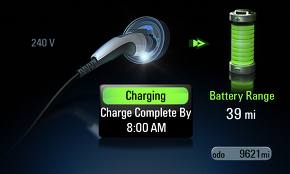I Want to Buy an Electric Vehicle Part 3: The Trade-Offs
Larry Chretien is the Executive Director for Mass Energy Consumers Alliance and People’s Power & Light. This blog...
Readers of this blog know that my family bought a 2015 Chevy Volt on August 21, 2014. I’m happy to report that two months later, we are thrilled with the car. After doing a lot of research on the Volt, Prius Plug-In and Nissan Leaf, we chose the Volt and it is exceeding our high expectations.
Background: The Volt is a plug-in hybrid. When the battery is fully charged, my Volt has a range of about 40 miles (I’ve gone 47), more than its 38 mile EPA rating. If I deplete the battery, the car runs on gasoline (actually gasoline fuels a generator that runs the motor on electricity).
One of the cool things about the Volt is that is that data about its performance in electric mode and gasoline mode is transmitted to General Motors and sent back to me in the form of useful, interesting reports. I can access data on-line about performance and other details in real time (on my computer or cell phone) and receive monthly summary reports.

So far, in a little over two months, we’ve driven 2553 miles, of which 1678, or 66%, have been electric, and 875 miles have been on gasoline. The total number of miles is higher than usual for us because we took a couple of longer, special trips that generally don’t happen every month. So we can see that over a 12-month period, the percentage of electric miles we drive should rise quite a bit.
Here’s a typical Volt dashboard display:

We normally charge the car up every night at home, using a standard 120 volt outlet. It takes about 8 hours to bring the car back up to a full charge after being nearly depleted. Just once have we charged away from home. Because the Volt can run on gasoline, we don’t depend upon having access to public charging stations. Although we are doing fine with 120 volts, we are now looking into getting a Level 2 or 240 volt charger that would cut the charging time to four hours. The benefit to that will be mostly on the weekends when we might be going in and out more during the day.
 In Massachusetts, a car driven on electricity with the resource mix that you would normally get from a supplier such as National Grid or NSTAR would greatly reduce a family’s carbon footprint. That’s because the Massachusetts electricity mix is getting cleaner all the time with less coal and oil and more renewables. But in my case, the carbon footprint of my Volt is especially small because my family’s electricity supply is Mass Energy’s New England Wind. That means than the 1678 miles driven on electricity had zero emissions.
In Massachusetts, a car driven on electricity with the resource mix that you would normally get from a supplier such as National Grid or NSTAR would greatly reduce a family’s carbon footprint. That’s because the Massachusetts electricity mix is getting cleaner all the time with less coal and oil and more renewables. But in my case, the carbon footprint of my Volt is especially small because my family’s electricity supply is Mass Energy’s New England Wind. That means than the 1678 miles driven on electricity had zero emissions.
By the way, we are getting about 40 miles per gallon in gasoline mode. We generally use gasoline only when we are driving above 50 miles per hour on the highway and are certain that we would exceed the 40 miles or so available from the battery power.
We are happy because the product is great. It does what it is intended to do. Aside from producing a lot of zero emission miles, the car is comfortable and fun to drive. But we are even happier that Chevy and its competitors are all working on various improvements. The combination of technological advancements, consumer acceptance, and public policies are all working. Without any buyer’s remorse, it’s great to know the 2016 Volt will be somewhat better than my car – capable of going further on a charge and with more acceleration. Furthermore, according to a General Motors press release , that roughly 70 percent of the 2016 Chevy Volt will be domestic content (made in USA) --up substantially from the 45 percent of the current model.
Take it from me. Now is a great time to buy an electric car. A nice selection to choose from. Federal tax credits of $7500. State rebates of $2500. What’s not to love?
Larry Chretien is the Executive Director for Mass Energy Consumers Alliance and People’s Power & Light. This blog...
Larry Chretien is the Executive Director for Mass Energy Consumers Alliance and People’s Power & Light. This blog...
Comments